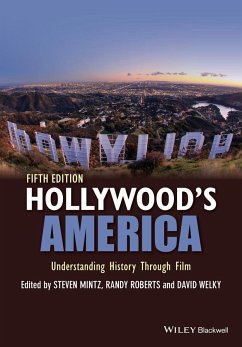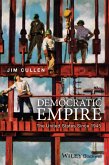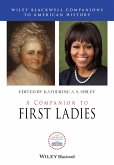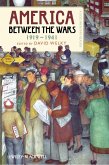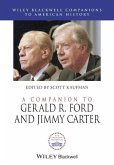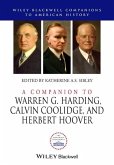Steven Mintz, Randy W. Roberts, David WelkyUnderstanding History Through Film
Hollywood's America
Understanding History Through Film
Ed. by Mintz, Steven; Roberts, Randy W.; Welky, David
Steven Mintz, Randy W. Roberts, David WelkyUnderstanding History Through Film
Hollywood's America
Understanding History Through Film
Ed. by Mintz, Steven; Roberts, Randy W.; Welky, David
- Broschiertes Buch
- Merkliste
- Auf die Merkliste
- Bewerten Bewerten
- Teilen
- Produkt teilen
- Produkterinnerung
- Produkterinnerung
Fully revised, updated, and extended, the fifth edition of Hollywood's America provides an important compilation of interpretive essays and primary documents that allows students to read films as cultural artifacts within the contexts of actual past events. _ A new edition of this classic textbook, which ties movies into the broader narrative of US and film history _ This fifth edition contains nine new chapters, with a greater overall emphasis on recent film history, and new primary source documents which are unavailable online _ Entries range from the first experiments with motion pictures…mehr
Andere Kunden interessierten sich auch für
![A Companion to Dwight D. Eisenhower A Companion to Dwight D. Eisenhower]() A Companion to Dwight D. Eisenhower228,99 €
A Companion to Dwight D. Eisenhower228,99 €![Democratic Empire Democratic Empire]() Jim CullenDemocratic Empire62,99 €
Jim CullenDemocratic Empire62,99 €![A Companion to First Ladies A Companion to First Ladies]() A Companion to First Ladies239,99 €
A Companion to First Ladies239,99 €![America Between the Wars, 1919-1941 America Between the Wars, 1919-1941]() America Between the Wars, 1919-194160,99 €
America Between the Wars, 1919-194160,99 €![A Companion to American Environmental History A Companion to American Environmental History]() A Companion to American Environmental History282,99 €
A Companion to American Environmental History282,99 €![A Companion to Gerald R. Ford and Jimmy Carter A Companion to Gerald R. Ford and Jimmy Carter]() A Companion to Gerald R. Ford and Jimmy Carter228,99 €
A Companion to Gerald R. Ford and Jimmy Carter228,99 €![A Companion to Warren G. Harding, Calvin Coolidge, and Herbert Hoover A Companion to Warren G. Harding, Calvin Coolidge, and Herbert Hoover]() A Companion to Warren G. Harding, Calvin Coolidge, and Herbert Hoover235,99 €
A Companion to Warren G. Harding, Calvin Coolidge, and Herbert Hoover235,99 €-
-
-
Fully revised, updated, and extended, the fifth edition of Hollywood's America provides an important compilation of interpretive essays and primary documents that allows students to read films as cultural artifacts within the contexts of actual past events.
_ A new edition of this classic textbook, which ties movies into the broader narrative of US and film history
_ This fifth edition contains nine new chapters, with a greater overall emphasis on recent film history, and new primary source documents which are unavailable online
_ Entries range from the first experiments with motion pictures all the way to the present day
_ Well-organized within a chronological framework with thematic treatments to provide a valuable resource for students of the history of American film
Hinweis: Dieser Artikel kann nur an eine deutsche Lieferadresse ausgeliefert werden.
_ A new edition of this classic textbook, which ties movies into the broader narrative of US and film history
_ This fifth edition contains nine new chapters, with a greater overall emphasis on recent film history, and new primary source documents which are unavailable online
_ Entries range from the first experiments with motion pictures all the way to the present day
_ Well-organized within a chronological framework with thematic treatments to provide a valuable resource for students of the history of American film
Hinweis: Dieser Artikel kann nur an eine deutsche Lieferadresse ausgeliefert werden.
Produktdetails
- Produktdetails
- Verlag: Wiley & Sons / Wiley-Blackwell
- Artikelnr. des Verlages: 1A118976490
- 5. Aufl.
- Seitenzahl: 448
- Erscheinungstermin: 7. März 2016
- Englisch
- Abmessung: 241mm x 168mm x 23mm
- Gewicht: 703g
- ISBN-13: 9781118976494
- ISBN-10: 1118976495
- Artikelnr.: 43853399
- Herstellerkennzeichnung
- Libri GmbH
- Europaallee 1
- 36244 Bad Hersfeld
- gpsr@libri.de
- Verlag: Wiley & Sons / Wiley-Blackwell
- Artikelnr. des Verlages: 1A118976490
- 5. Aufl.
- Seitenzahl: 448
- Erscheinungstermin: 7. März 2016
- Englisch
- Abmessung: 241mm x 168mm x 23mm
- Gewicht: 703g
- ISBN-13: 9781118976494
- ISBN-10: 1118976495
- Artikelnr.: 43853399
- Herstellerkennzeichnung
- Libri GmbH
- Europaallee 1
- 36244 Bad Hersfeld
- gpsr@libri.de
Steven Mintz is Professor of History at the University of Texas at Austin and Executive director of the University of Texas System's Institute for Transformational Learning. He is the author and editor of fourteen books, including The Prime of Life: A History of Modern Adulthood, Huck's Raft: A History of American Childhood, and Domestic Revolutions: A Social History of American Family Life. He is the editor of African American Voices (4th edition, Wiley-Blackwell, 2009), Mexican American Voices (2nd edition, Wiley-Blackwell, 2009), and Native American Voices (2nd edition, Wiley-Blackwell, 2000). Randy Roberts is Distinguished Professor of History at Purdue University. His publications include John Wayne American (with James S. Olson, 1995), A Line in the Sand: The Alamo in Blood and Memory (with James S. Olson,2000), Joe Louis: Hard Times Man (2010), A Team for America: The Army-Navy Game That Rallied a Nation (2011) and Rising Tide: Bear Bryant, Joe Namath and Dixie's Last Quarter (with Ed Krzemienski, 2014). Roberts has served frequently as a consultant and on-camera commentator for PBS, HBO, and the History Channel. David Welky is a Professor of History at the University of Central Arkansas. Among his most recent publications are The Moguls and the Dictators: Hollywood and the Coming of World War II (2008), Everything was Better in America: Mainstream Print Culture and the Great Depression (2008), The Thousand-Year Flood: The Ohio-Mississippi Disaster of 1937 (2011), America Between the Wars, 1919-1941: A Documentary Reader (Wiley-Blackwell, 2011), John Wayne (with Randy Roberts, 2012), and Marching Across the Color Line: A. Philip Randolph and Civil Rights in the World War II Era (2013).
List of Illustrations ix
Preface xi
Introduction: The Social and Cultural History of American Film 1
PART I THE SILENT ERA 31
Introduction: Intolerance and the Rise of the Feature Film 31
1 Workers in Early Film 33
Michael Shull, "Silent Agitators: Militant Labor in the Movies, 1909-1919"
2 Silent Cinema as Historical Mythmaker 42
Eric Niderost, "The Birth of a Nation"
3 The Revolt Against Victorianism 51
Lary May, "Douglas Fairbanks, Mary Pickford, and the New Personality"
4 Primary Sources 63
Edison v. American Mutoscope Company 63
"The Nickel Madness" 65
Mutual Film Corp. v. Industrial Commission of Ohio 68
Fighting a Vicious Film: Protest Against The Birth of a Nation 69
Boston Branch of the National Association for the Advancement of Colored People, 1915 69
Analysis by Francis Hackett 69
"Seeing Our Boys 'Over There'" 71
PART II HOLLYWOOD'S GOLDEN AGE 75
Introduction: Backstage During the Great Depression: 42nd Street, Gold Diggers of 1933, and Footlight Parade 75
5 Depression America and its Films 79
Maury Klein, "Laughing Through Tears"
6 The Depression's Human Toll 86
Peter Roffman and Jim Purdy, "Gangsters and Fallen Women"
7 Depression Allegories 95
Thomas H. Pauly, "Gone with the Wind and The Grapes of Wrath as Hollywood Histories of the Great Depression"
8 African Americans on the Silver Screen 104
Thomas R. Cripps, "The Evolution of Black Film"
9 Primary Sources 116
The Introduction of Sound 116
"Pictures That Talk" 116
Review of Don Juan 117
"Silence is Golden" 118
Film Censorship 120
The Sins of Hollywood, 1922 120
"The Don'ts and Be Carefuls" 122
The Motion Picture Production Code of 1930 123
The State Department on Hollywood in Germany, 1934 133
The State Department on Hollywood in Latin America, 1934 134
PART III HOLLYWOOD IN THE WORLD WAR II ERA 137
Introduction: Hollywood's World War II Combat Films 137
10 Movies and Great Britain 141
Michael Todd Bennett, "Anglophilia on Film: Creating an Atmosphere for Alliance, 1935-1941"
11 Blockbuster as Propaganda 156
Randy Roberts, "You Must Remember This: The Case of Hal Wallis's Casablanca"
12 John Wayne and Wartime Hollywood 166
Randy Roberts, "John Wayne Goes to War"
13 The Woman's Film 184
Jeanine Basinger, "When Women Wept"
14 Primary Sources 191
Sumner Welles to Franklin Roosevelt, 1941 191
The 1941 Academy Awards: Hollywood and the President 192
Correspondence between Walter Wanger and Stephen Early 192
Franklin D. Roosevelt to the Academy Awards Dinner 195
Walter Wanger to Stephen Early 196
Madeleine Carroll to Franklin Roosevelt 196
U.S. Senate Subcommittee Hearings on Motion Picture and Radio Propaganda, 1941 196
Excerpts from The Government Information Manual for the Motion Picture Industry, 1942 200
Bureau of Motion Pictures Report: Casablanca 204
PART IV POSTWAR HOLLYWOOD 207
Introduction: Double Indemnity and Film Noir 207
15 The Red Scare in Hollywood 211
Peter Roffman and Jim Purdy, "HUAC and the End of an Era"
16 Movies Grow Up 219
Jennifer Holt, "Hollywood and Politics Caught in the Cold War Crossfire"
17 The Morality of Informing 229
Kenneth R. Hey, "Ambivalence and On the Waterfront"
Preface xi
Introduction: The Social and Cultural History of American Film 1
PART I THE SILENT ERA 31
Introduction: Intolerance and the Rise of the Feature Film 31
1 Workers in Early Film 33
Michael Shull, "Silent Agitators: Militant Labor in the Movies, 1909-1919"
2 Silent Cinema as Historical Mythmaker 42
Eric Niderost, "The Birth of a Nation"
3 The Revolt Against Victorianism 51
Lary May, "Douglas Fairbanks, Mary Pickford, and the New Personality"
4 Primary Sources 63
Edison v. American Mutoscope Company 63
"The Nickel Madness" 65
Mutual Film Corp. v. Industrial Commission of Ohio 68
Fighting a Vicious Film: Protest Against The Birth of a Nation 69
Boston Branch of the National Association for the Advancement of Colored People, 1915 69
Analysis by Francis Hackett 69
"Seeing Our Boys 'Over There'" 71
PART II HOLLYWOOD'S GOLDEN AGE 75
Introduction: Backstage During the Great Depression: 42nd Street, Gold Diggers of 1933, and Footlight Parade 75
5 Depression America and its Films 79
Maury Klein, "Laughing Through Tears"
6 The Depression's Human Toll 86
Peter Roffman and Jim Purdy, "Gangsters and Fallen Women"
7 Depression Allegories 95
Thomas H. Pauly, "Gone with the Wind and The Grapes of Wrath as Hollywood Histories of the Great Depression"
8 African Americans on the Silver Screen 104
Thomas R. Cripps, "The Evolution of Black Film"
9 Primary Sources 116
The Introduction of Sound 116
"Pictures That Talk" 116
Review of Don Juan 117
"Silence is Golden" 118
Film Censorship 120
The Sins of Hollywood, 1922 120
"The Don'ts and Be Carefuls" 122
The Motion Picture Production Code of 1930 123
The State Department on Hollywood in Germany, 1934 133
The State Department on Hollywood in Latin America, 1934 134
PART III HOLLYWOOD IN THE WORLD WAR II ERA 137
Introduction: Hollywood's World War II Combat Films 137
10 Movies and Great Britain 141
Michael Todd Bennett, "Anglophilia on Film: Creating an Atmosphere for Alliance, 1935-1941"
11 Blockbuster as Propaganda 156
Randy Roberts, "You Must Remember This: The Case of Hal Wallis's Casablanca"
12 John Wayne and Wartime Hollywood 166
Randy Roberts, "John Wayne Goes to War"
13 The Woman's Film 184
Jeanine Basinger, "When Women Wept"
14 Primary Sources 191
Sumner Welles to Franklin Roosevelt, 1941 191
The 1941 Academy Awards: Hollywood and the President 192
Correspondence between Walter Wanger and Stephen Early 192
Franklin D. Roosevelt to the Academy Awards Dinner 195
Walter Wanger to Stephen Early 196
Madeleine Carroll to Franklin Roosevelt 196
U.S. Senate Subcommittee Hearings on Motion Picture and Radio Propaganda, 1941 196
Excerpts from The Government Information Manual for the Motion Picture Industry, 1942 200
Bureau of Motion Pictures Report: Casablanca 204
PART IV POSTWAR HOLLYWOOD 207
Introduction: Double Indemnity and Film Noir 207
15 The Red Scare in Hollywood 211
Peter Roffman and Jim Purdy, "HUAC and the End of an Era"
16 Movies Grow Up 219
Jennifer Holt, "Hollywood and Politics Caught in the Cold War Crossfire"
17 The Morality of Informing 229
Kenneth R. Hey, "Ambivalence and On the Waterfront"
List of Illustrations ix
Preface xi
Introduction: The Social and Cultural History of American Film 1
PART I THE SILENT ERA 31
Introduction: Intolerance and the Rise of the Feature Film 31
1 Workers in Early Film 33
Michael Shull, "Silent Agitators: Militant Labor in the Movies, 1909-1919"
2 Silent Cinema as Historical Mythmaker 42
Eric Niderost, "The Birth of a Nation"
3 The Revolt Against Victorianism 51
Lary May, "Douglas Fairbanks, Mary Pickford, and the New Personality"
4 Primary Sources 63
Edison v. American Mutoscope Company 63
"The Nickel Madness" 65
Mutual Film Corp. v. Industrial Commission of Ohio 68
Fighting a Vicious Film: Protest Against The Birth of a Nation 69
Boston Branch of the National Association for the Advancement of Colored People, 1915 69
Analysis by Francis Hackett 69
"Seeing Our Boys 'Over There'" 71
PART II HOLLYWOOD'S GOLDEN AGE 75
Introduction: Backstage During the Great Depression: 42nd Street, Gold Diggers of 1933, and Footlight Parade 75
5 Depression America and its Films 79
Maury Klein, "Laughing Through Tears"
6 The Depression's Human Toll 86
Peter Roffman and Jim Purdy, "Gangsters and Fallen Women"
7 Depression Allegories 95
Thomas H. Pauly, "Gone with the Wind and The Grapes of Wrath as Hollywood Histories of the Great Depression"
8 African Americans on the Silver Screen 104
Thomas R. Cripps, "The Evolution of Black Film"
9 Primary Sources 116
The Introduction of Sound 116
"Pictures That Talk" 116
Review of Don Juan 117
"Silence is Golden" 118
Film Censorship 120
The Sins of Hollywood, 1922 120
"The Don'ts and Be Carefuls" 122
The Motion Picture Production Code of 1930 123
The State Department on Hollywood in Germany, 1934 133
The State Department on Hollywood in Latin America, 1934 134
PART III HOLLYWOOD IN THE WORLD WAR II ERA 137
Introduction: Hollywood's World War II Combat Films 137
10 Movies and Great Britain 141
Michael Todd Bennett, "Anglophilia on Film: Creating an Atmosphere for Alliance, 1935-1941"
11 Blockbuster as Propaganda 156
Randy Roberts, "You Must Remember This: The Case of Hal Wallis's Casablanca"
12 John Wayne and Wartime Hollywood 166
Randy Roberts, "John Wayne Goes to War"
13 The Woman's Film 184
Jeanine Basinger, "When Women Wept"
14 Primary Sources 191
Sumner Welles to Franklin Roosevelt, 1941 191
The 1941 Academy Awards: Hollywood and the President 192
Correspondence between Walter Wanger and Stephen Early 192
Franklin D. Roosevelt to the Academy Awards Dinner 195
Walter Wanger to Stephen Early 196
Madeleine Carroll to Franklin Roosevelt 196
U.S. Senate Subcommittee Hearings on Motion Picture and Radio Propaganda, 1941 196
Excerpts from The Government Information Manual for the Motion Picture Industry, 1942 200
Bureau of Motion Pictures Report: Casablanca 204
PART IV POSTWAR HOLLYWOOD 207
Introduction: Double Indemnity and Film Noir 207
15 The Red Scare in Hollywood 211
Peter Roffman and Jim Purdy, "HUAC and the End of an Era"
16 Movies Grow Up 219
Jennifer Holt, "Hollywood and Politics Caught in the Cold War Crossfire"
17 The Morality of Informing 229
Kenneth R. Hey, "Ambivalence and On the Waterfront"
Preface xi
Introduction: The Social and Cultural History of American Film 1
PART I THE SILENT ERA 31
Introduction: Intolerance and the Rise of the Feature Film 31
1 Workers in Early Film 33
Michael Shull, "Silent Agitators: Militant Labor in the Movies, 1909-1919"
2 Silent Cinema as Historical Mythmaker 42
Eric Niderost, "The Birth of a Nation"
3 The Revolt Against Victorianism 51
Lary May, "Douglas Fairbanks, Mary Pickford, and the New Personality"
4 Primary Sources 63
Edison v. American Mutoscope Company 63
"The Nickel Madness" 65
Mutual Film Corp. v. Industrial Commission of Ohio 68
Fighting a Vicious Film: Protest Against The Birth of a Nation 69
Boston Branch of the National Association for the Advancement of Colored People, 1915 69
Analysis by Francis Hackett 69
"Seeing Our Boys 'Over There'" 71
PART II HOLLYWOOD'S GOLDEN AGE 75
Introduction: Backstage During the Great Depression: 42nd Street, Gold Diggers of 1933, and Footlight Parade 75
5 Depression America and its Films 79
Maury Klein, "Laughing Through Tears"
6 The Depression's Human Toll 86
Peter Roffman and Jim Purdy, "Gangsters and Fallen Women"
7 Depression Allegories 95
Thomas H. Pauly, "Gone with the Wind and The Grapes of Wrath as Hollywood Histories of the Great Depression"
8 African Americans on the Silver Screen 104
Thomas R. Cripps, "The Evolution of Black Film"
9 Primary Sources 116
The Introduction of Sound 116
"Pictures That Talk" 116
Review of Don Juan 117
"Silence is Golden" 118
Film Censorship 120
The Sins of Hollywood, 1922 120
"The Don'ts and Be Carefuls" 122
The Motion Picture Production Code of 1930 123
The State Department on Hollywood in Germany, 1934 133
The State Department on Hollywood in Latin America, 1934 134
PART III HOLLYWOOD IN THE WORLD WAR II ERA 137
Introduction: Hollywood's World War II Combat Films 137
10 Movies and Great Britain 141
Michael Todd Bennett, "Anglophilia on Film: Creating an Atmosphere for Alliance, 1935-1941"
11 Blockbuster as Propaganda 156
Randy Roberts, "You Must Remember This: The Case of Hal Wallis's Casablanca"
12 John Wayne and Wartime Hollywood 166
Randy Roberts, "John Wayne Goes to War"
13 The Woman's Film 184
Jeanine Basinger, "When Women Wept"
14 Primary Sources 191
Sumner Welles to Franklin Roosevelt, 1941 191
The 1941 Academy Awards: Hollywood and the President 192
Correspondence between Walter Wanger and Stephen Early 192
Franklin D. Roosevelt to the Academy Awards Dinner 195
Walter Wanger to Stephen Early 196
Madeleine Carroll to Franklin Roosevelt 196
U.S. Senate Subcommittee Hearings on Motion Picture and Radio Propaganda, 1941 196
Excerpts from The Government Information Manual for the Motion Picture Industry, 1942 200
Bureau of Motion Pictures Report: Casablanca 204
PART IV POSTWAR HOLLYWOOD 207
Introduction: Double Indemnity and Film Noir 207
15 The Red Scare in Hollywood 211
Peter Roffman and Jim Purdy, "HUAC and the End of an Era"
16 Movies Grow Up 219
Jennifer Holt, "Hollywood and Politics Caught in the Cold War Crossfire"
17 The Morality of Informing 229
Kenneth R. Hey, "Ambivalence and On the Waterfront"

